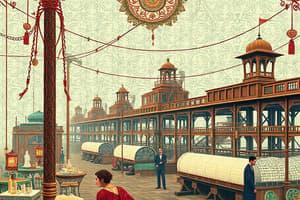Podcast
Questions and Answers
What was the literacy rate in India at the time of independence?
What was the literacy rate in India at the time of independence?
- Just above 18 percent (correct)
- Above 50 percent
- Less than 10 percent
- Around 32 percent
What was the average life expectancy in India in 1951?
What was the average life expectancy in India in 1951?
- 60 years
- 40 years
- 32 years (correct)
- 50 years
What was the main goal of India's development strategy after independence?
What was the main goal of India's development strategy after independence?
- Slow and steady economic growth
- Rapid economic growth with minimal government intervention
- Rapid industrialization with private sector dominance
- Rapid economic growth accompanied by equity and distributive justice (correct)
What was the role of the Planning Commission of India?
What was the role of the Planning Commission of India?
What was the cornerstone of Nehru's development strategy?
What was the cornerstone of Nehru's development strategy?
What was the ideology of industrialization prevalent in early independent India?
What was the ideology of industrialization prevalent in early independent India?
What was the purpose of the five-year plans in India?
What was the purpose of the five-year plans in India?
What areas did the state have a monopoly in, according to the Industrial Policy Resolution of 1948?
What areas did the state have a monopoly in, according to the Industrial Policy Resolution of 1948?
What were the two economic philosophies that guided policies in the 1950s?
What were the two economic philosophies that guided policies in the 1950s?
What was the outcome of the undue priority given to the public sector?
What was the outcome of the undue priority given to the public sector?
What was the average annual rate of growth of GDP in India during the first three decades after independence?
What was the average annual rate of growth of GDP in India during the first three decades after independence?
What was the focus of the first decade and a half of development in India?
What was the focus of the first decade and a half of development in India?
Flashcards are hidden until you start studying
Study Notes
India at Independence
- India was largely rural, with an overwhelmingly illiterate population, and over 80% of the population lived in rural areas.
- The literacy rate was just above 18% and life expectancy was barely 32 years in 1951.
- The country had a deeply stratified society characterized by extreme heterogeneity in many ways.
Economic Policy and Planning
- The Nehruvian model, which supported social and economic redistribution and industrialization directed by the state, dominated India's economic policy after independence.
- Centralized economic planning and direction were at the core of India's development strategy.
- The Planning Commission of India was established to plan India's economic development in line with the socialistic strategy.
- The five-year plans were developed, implemented, and monitored by the Planning Commission.
Industrialization and Policy
- Rapid industrialization was the cornerstone of Nehru's development strategy.
- The concept of 'planned modernization' meant systematic planning to support industrialization.
- The Industrial Policy Resolution (1948) envisioned an expanded role for the public sector and licensing to the private sector.
- The state was granted a monopoly in strategic areas such as atomic energy, arms, and ammunition, and railways.
- The rights to new investments in basic industries were exclusively given to the state.
Economic Philosophies and Challenges
- The policies in the 1950s were guided by two economic philosophies: Nehru's visualization of building a socialistic society with emphasis on heavy industry, and Gandhi's philosophy of small-scale and cottage industry and village republics.
- The Industrial Policy Resolution of 1956 provided a comprehensive framework for industrial development but was lopsided, supporting an enormous expansion of the public sector.
- This led to the dampening of private initiative and enterprise.
Trade Policy and Balance of Payments Crisis
- India followed an open foreign investment policy and a relatively open trade policy until the late 1950s.
- A balance of payments crisis emerged in 1958, causing concerns regarding foreign exchange depletion.
- This led to a gradual tightening of trade and reduction in investment-licensing of new investments requiring imports of capital goods.
Economic Growth and Development
- India's average annual rate of growth of GDP during the first three decades after independence (1950-80) was a modest 3.5 percent.
- The thrust of the first decade and a half was on capital goods, such as dams, power plants, and heavy industrialization, rather than consumer goods.
Studying That Suits You
Use AI to generate personalized quizzes and flashcards to suit your learning preferences.




